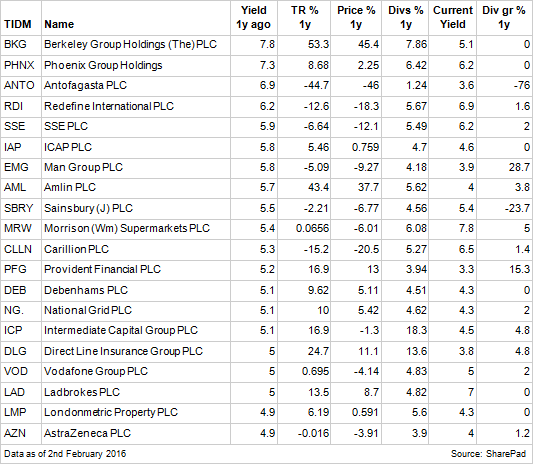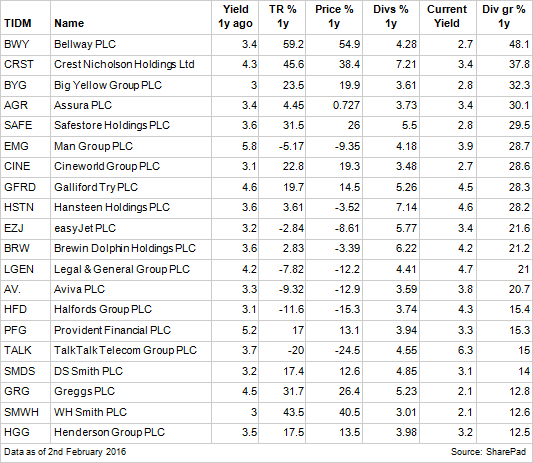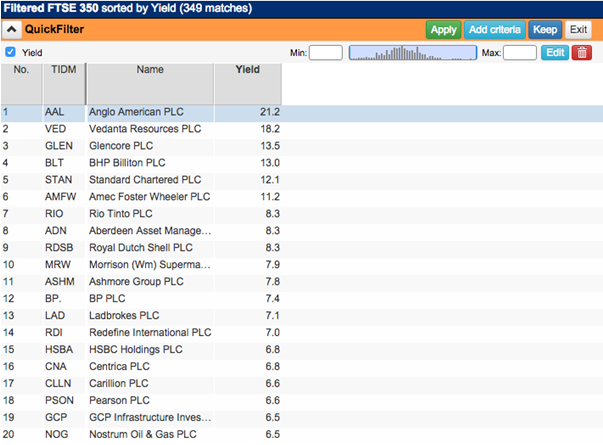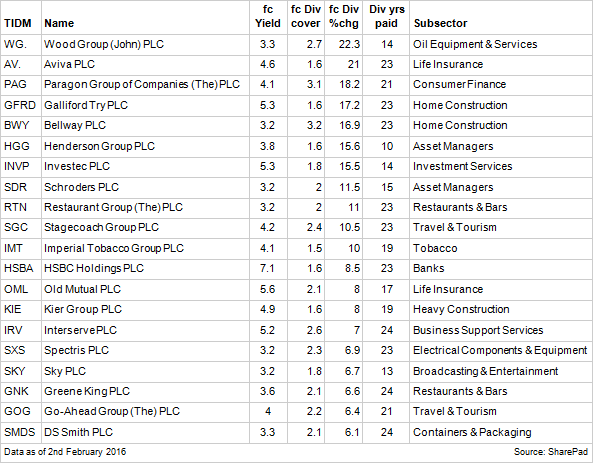Dividend investing - high yield or dividend growth?
Dividends are a slice of a company's profits that are paid to shareholders. They are also an important part of the total return that you get from owning a share - even more so if you reinvest them.
Dividends represent a tangible return from a share which once paid cannot be taken away. The same cannot be said for share prices that can be up one day and down the next.
It is this flow of cash that has made dividend investing so popular with so many private investors. But dividends have other things going for them too.
They tend to be much more stable than share prices and therefore can reduce the volatility of a portfolio (how much its value moves up and down) which can take some of the fear out of stock market investing and make for a better night's sleep.
But what's the best way to invest in dividend-paying shares?
I decided to open up SharePad to try and get an answer to this question. Just out of curiosity I wanted to compare the performance of two different dividend portfolios over the last year.
One was based on the twenty shares with the highest dividend yields in the FTSE 350 index. The second portfolio looked at the performance of the twenty shares that delivered the highest rates of dividend growth. Both portfolios were equally-weighted (the same amount of money invested in each share).
Phil Oakley's debut book - out now!

Phil shares his investment approach in his new book How to Pick Quality Shares. If you've enjoyed his weekly articles, newsletters and Step-by-Step Guide to Stock Analysis, this book is for you.
Share this article with your friends and colleagues:
Dividend Dogs of 2015
The high yield portfolio selected the shares with the highest dividend yields back in February 2015. Dividend yield in this case was calculated by dividing the most recent annual dividend per share by the share price at that time.
This high yield strategy is very similar to the 'Dogs of the Dow' strategy made popular by Michael B O'Higgins in his book, Beating the Dow. The strategy is based upon buying the ten highest-yielding shares in the Dow Jones index and had a good track record from 1920 to 1990. Since the early 1990s its ability to beat the market has not been as good.
It's worth pointing out here something that might not be obvious to less experienced investors. High dividend yields often occur when a company's share price has fallen a long way. For example, a share price of 100p with a dividend of 4p gives a 4% yield. If the share price falls to 50p, you've now got a yield of 8%. That's why this strategy refers to 'dogs' - shares that have done badly. Having said that, not all shares in the portfolio will be in this category - some will have a genuinely generous dividend.
The twenty shares selected for the Dividend Dogs portfolio from the FTSE 350 are shown in the table below.

The table above shows you how you can use SharePad to break down the total return of a share between price changes and dividends received. The first column shows the dividend yield at the start of February 2015. The next column shows the total return (share price plus dividends received) over the past year. The following two columns break down that total return between price and dividends. The final two columns show the yield in February 2016 and the rate of dividend growth over the past year.
This portfolio produced a total return of 6.14% in the year to 1st February 2016. This compares favourably with a total return of -6.6% for the FTSE All Share index over the same time period. Thirteen shares made money with seven shares losing money.
Berkeley Group and Amlin were the biggest gainers with total returns of 53.3% and 43.4% respectively. Here most of the gains were due to increases in their share prices.
The third best performer was Direct Line with a total return of 24.7%. Here the experience was slightly different with most of the return coming from dividends received rather than a share price increase.
Antofagasta was the worst performer with a total return of minus 44.7% as dividends were cut on top of a sharp fall in its share price. Carillion posted a negative total return of 15.2% despite growing its dividend slightly.
What's more revealing is that if the three best performing shares - Berkeley Group, Amlin and Direct Line - were excluded, this portfolio would not have made any money at all. It would have still beaten the stock market as a whole, but this is not really much comfort to most people.
This experience is a good example of what can happen to the performance of your investments when you follow a numbers-based strategy - it gets watered down. You dilute the returns of your portfolio by owning lower quality shares that offset the results from the good ones. This process has often been referred to as diworsification by investing commentators.
To make good money from owning shares you ideally need to concentrate your investments into fewer higher quality shares. You can only really do this by knowing what you own and doing a bit of research. Knowing what you own and understanding how it makes money is how investors such as Warren Buffett reduce their risk - not by owning lots of different shares some of which might not be any good.
Sometimes though you can get lucky by buying lots of different shares. This is often the case when a particular investing style is very popular.
What about dividend growth?
With a few exceptions, most of these high-yielding shares are not growing their dividends much. This lack of growth is one of the main reasons why the shares have high dividend yields - a low valuation - in the first place.
In order to compensate investors for low profits growth in the future, a big fat dividend is offered to them by paying out most of a company's profits. It is often the case that a very high dividend yield is also a sign that the stock market thinks that the dividend is likely to be cut in the future. This can make this strategy more rather than less risky.
Dividend growth is what turbo-charges the returns from shares to investors. As well as pocketing a growing stream of income, the share price often moves up to take account of that growth and gives investors a capital gain on top. Without growth and the hope of more growth in the future, shareholders would end up getting most of their returns from a flat dividend payment much like they would from owning a bond.
So I've decided to look at how a portfolio of shares with more modest dividend yields but with some dividend growth would have performed over the last year. I've asked SharePad to find me shares with a dividend yield of at least 3% a year ago which then delivered dividend growth of at least 5%. I then looked at the performance of the twenty shares with the highest dividend growth.
These 20 shares did better, with a return of 14.2% for the biggest dividend growers. The portfolio is shown below with the shares ranked in order of dividend growth.

Here 14 shares made money with 6 shares losing money. Housebuilders Bellway and Crest Nicholson delivered stellar total returns on the back of big dividend increases which accompanied a big increase in their share prices.
Other shares such as Legal & General, Aviva, Halfords and Talk Talk have lost money despite posting big dividend increases - presumably because the stock market has some doubts about future dividend growth.
A common factor with many of the winning shares in this portfolio is that their share prices have grown faster than their dividends. This means that their dividend yields today are lower than they were a year ago i.e. the shares are more expensive on this measure.
However, as far as the last year is concerned dividend growth was a better investment strategy than buying shares with high dividend yields.
Will the same thing happen over the next twelve months?
Has the dog had its day?
The Dow dogs strategy has a reasonable amount of common sense behind it. Shares with high dividend yields have often been shunned by investors and in some cases might be undervalued.
Another possibility is that high dividend yields are a sign that the shares are complete basket cases with unsustainable dividend payments. If you look at a list of the highest yielding shares from the FTSE 350 today you could be forgiven for coming to this conclusion.

Most of these companies have announced that they are going to cut their dividends in the future or the stock market believes that their dividends are at risk. This might be a list of depressed shares which might appeal to contrarian investors but if you are looking for a source of income to live on then the chances are you will not live well.
A list of possible dividend growers today
With the aim of finding a portfolio of decent dividend growth shares I've asked SharePad to look for shares which meet the following criteria:
- A minimum forecast dividend yield of at least 3% - a reasonable starting level of income.
- Dividend cover of at least 1.5 times - some safety built in.
- Forecast dividend growth for the next year of between 5% and 25%.
- A solid dividend history. Companies that have paid a dividend for at least ten consecutive years.
Essentially I am looking for a list of shares that have been dependable dividend payers in the past with good chance of being so in the future. I wouldn't invest on the basis of analysts' forecasts as they tend to be quite bad at predicting changes in companies' fortunes. A thorough study of the company's financial history and recent trends has always been my preferred approach.
Here is a list of twenty shares ranked in order of expected dividend growth which meet my criteria for further research.

I will keep track of this over the next few months and report back to you on how these shares are performing.
If you have found this article of interest, please feel free to share it with your friends and colleagues:
We welcome suggestions for future articles - please email me at analysis@sharescope.co.uk. You can also follow me on Twitter @PhilJOakley. If you'd like to know when a new article or chapter for the Step-by-Step Guide is published, send us your email address using the form at the top of the page. You don't need to be a subscriber.
This article is for educational purposes only. It is not a recommendation to buy or sell shares or other investments. Do your own research before buying or selling any investment or seek professional financial advice.